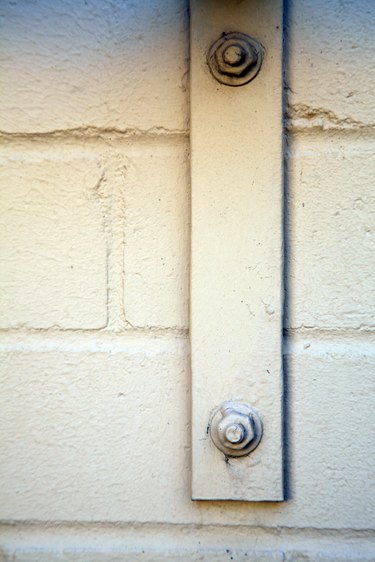Things You'll Need
Wire brush
Rubber gloves
Mild dishwashing detergent
Sandpaper, 80 grit and 120 grit
Lint-free cloth
Lime
Salt
Water
Skim milk
Paintbrush
Plastic container
Water-based sealer, satin finish

Whitewash has been used for centuries to brighten and disinfect surfaces. The process involves painting a thin, watery coating over the surface of the intended item. This semi-transparent paint mixture brings out details and lets the surface underneath show through. The finish gives a fresh, clean feel. Many coastal and country decors feature a whitewashed look. When using whitewash with metal, it is important to prepare the metal properly to ensure the whitewash will adhere to the surface.
Step 1
Remove any rust from the item intended for whitewashing. Brush the item completely, using a wire brush to remove rust and other debris.
Video of the Day
Step 2
Wash the item with a mild detergent and water solution, using a lint-free cloth. Remove the detergent mixture residue with a damp, clean cloth.
Step 3
Sand the entire item to create a receptive surface for the whitewash to adhere to, using 80-grit sandpaper. Sand a second time using 120-grit sandpaper.
Step 4
Wash sandpaper residue and dust from the item with a mild detergent and water solution, using a soft cloth. Remove the detergent residue from the item with a damp cloth and allow to dry thoroughly.
Step 5
Put on rubber gloves. Mix 12 cups lime, 4 cups salt, 2 gallons tap water and 1/2 gallon skim milk in a large plastic container. The wash is watery.
Step 6
Paint the metal object in smooth, even strokes in one direction, using a paintbrush. Work in small sections, since the whitewash tends to dry quickly.
Step 7
Wipe the damp metal surface of excess whitewash as you go along to achieve the look desired. Wipe drips on the metal. Allow the surface to dry completely.
Step 8
Repeat the process in Step 6 and 7 until the desired level of coverage is achieved. This is a personal choice. Allow the whitewash to dry thoroughly between coats.
Step 9
Apply a protective coat to the dry, whitewashed surface using a paintbrush and a water-based sealant, according to the manufacturer's instructions.
Tip
Commercially prepared whitewash is available at home improvement centers and paint supply outlets. Mix two parts white latex paint and one part tap water to create a whitewash solution, as an alternative, if you do not want to use the old-fashioned whitewash recipe. Using latex paint and water prevents a chalky look to the finish, as well as allowing you to avoid working with lime, a caustic substance.
Video of the Day